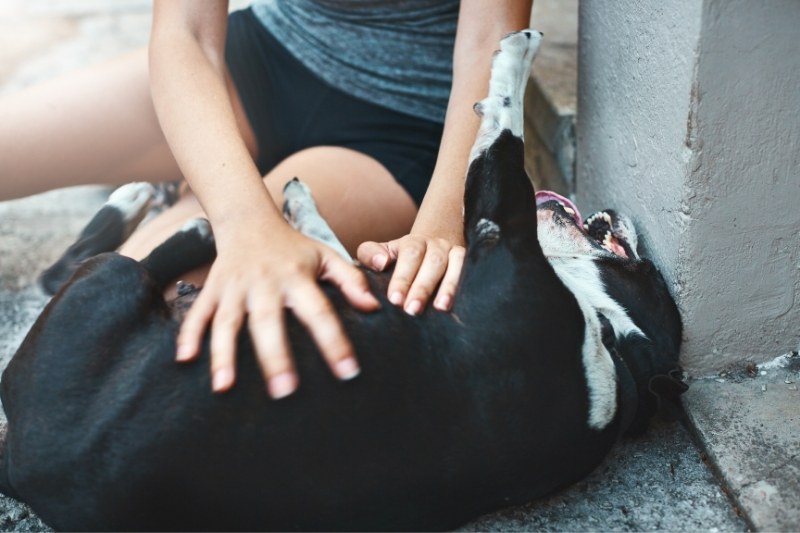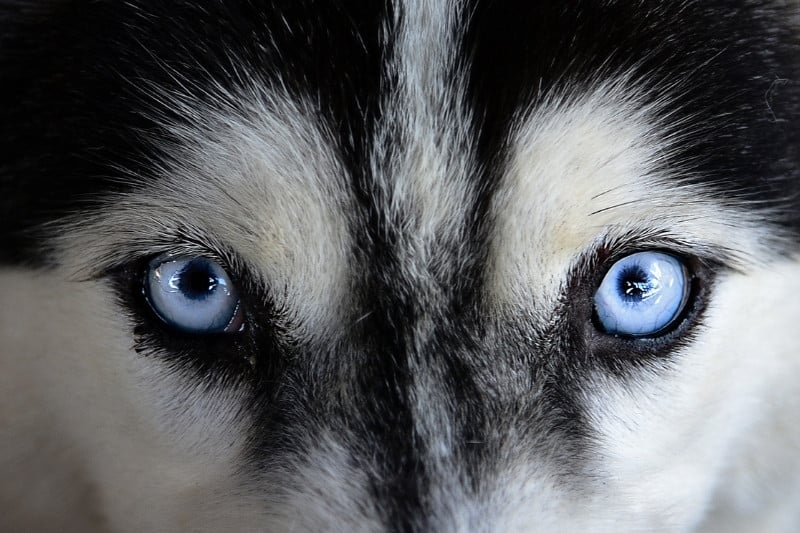When were dogs domesticated? A complete guide to the evolution of dogs

Grab yourself a coffee and get your pup up on your lap – here’s everything you need to know about the history of dogs and where they come from.
📝 This article summarized in 5 key points
- Dogs evolved from gray wolves and were domesticated between 15,000 and 30,000 years ago.
- Two main theories exist on dog domestication: human-led domestication and self-domestication by wolves.
- Evidence suggests dogs were domesticated multiple times in different locations.
- The domestication of dogs has led to a wide variety of breeds with diverse physical and behavioral traits.
- Most dog breeds were developed during the last 200 years, particularly during the Victorian era, marking a significant period of breed creation and diversification.
What is a dog?
It’s an odd question, sure. But what makes a dog a dog?
How can a Dalmatian be the same species as a Pomeranian? Or a Mastiff the same as a Toy Poodle? What really makes an animal a dog is not their size, coat type, nose length, or adorable personality. It’s that all dogs have 39 pairs of chromosomes.
It’s this unique combination that makes all 400 plus breeds the same species (even if it’s sometimes hard to believe).
When were dogs domesticated?

The evolution of dogs isn’t a certain thing.
In some cases, there’s even very little information about breeds that have developed in the last 40 years, so you can imagine scientists and paleontologists disagree a bit about when and exactly how dogs evolved into being our pups that run around a doggie park today.
Based on extensive genetic studies, however, they do agree that dogs are descendants of they grey wolf, Canis lupus.
Theory nº1: Dogs are man-made
One theory is that dogs are man-made – so to speak. Before humans evolved to have homes, a garden, and a yard for our pets to play in, we were nomadic. We traveled around depending on the season, food sources, and shelter. This way of life naturally made us encounter more wildlife, one of which was an extinct wolf species similar to the gray wolf of today, Canis lupus.
Much like wolves of today, they were fierce, loyal animals that were exceptional hunters. Obviously, humans would have seen the benefits of having these incredible animals on ‘their team’. If they could be more domesticated, they could help them to hunt, protect them from other animals such as bears, and even work to help pull their belongings in their nomadic lifestyle. They could become loyal pets.
This theory would mean that humans adopted a wolf puppy in the hope of taming it into adulthood. The puppy, in turn, would breed and have litters of tamer and more domesticated wolves which would be the start of dogs as we know them today.
Some scientists disagree with this opinion based on the fact that wolf puppies are just so hard to train. Wolves are naturally very wild and have high instincts which make them unlikely to just ‘become’ domesticated because a human finds them cute and potentially useful. They are fierce and have a very high prey drive, even as puppies.
Theory nº2: Wolves domesticated themselves
Another possible answer to how did humans domesticate dogs? is that they didn’t at all. The wolves domesticated themselves.
Just like our dogs today, wolves are incredibly intelligent and would have caught on quickly that following humans meant they didn’t have to hunt as much.
They could scavenge the leftovers from their food whilst being taken to water supplies. And if they didn’t leave enough food behind, the humans would be leading them to where all the prey was. It made their lives a lot simpler.
Over time (and probably quite a lot of it), these wolves would have begun to feel more comfortable around humans. In turn, they would have raised tamer pups that recognized humans and which eventually became what we call dogs. Both the wolves and the humans would have seen the benefits of having the other around.
So, how long ago was this?
It might not surprise you to know that scientists disagree on this too. Some think it was 15,000 years ago and others believe it was almost double that. There are a few early stone drawings that can give us a better indication of when dogs were more domesticated (although it’s likely this happened way before the pictures depict it).
Scientists believe the oldest paintings of dogs can be found in the Arabian Desert – they likely date back 8000 years.
There’s also a lot of evidence to show that the Ancient Egyptians kept dogs. Some were used as guard dogs, some as hunters, and others were family pets.
It’s likely that the dogs were Basenjis, Greyhounds, Pharaohs, and Salukis. The Egyptians loved their pets so much that it wasn’t unusual for dogs and cats to be mummified with them to protect them and keep them entertained in the afterlife.
There are drawings on countless numbers of excavated buildings in Egypt showing humans and dogs hunting together or sitting together as if they’re household pets.
Where were dogs first domesticated?
When it comes to the history of dogs, geography also plays an important part, but again, Scientists are not 100% sure where the origin of dogs happened. Using ancient and modern wolf and dog DNA, they believe it most likely happened in Europe, East Asia, Mongolia, Siberia, and Africa.
It could, of course, have happened simultaneously in many places around the world. There doesn’t have to be one location in which one wolf was gradually tamed. It’s quite likely that dogs evolved from two different wolf populations in West and East Eurasia.
Eventually, travelers brought Asian dogs to the West where they mated with European dogs and evolved into some of the breeds we would recognize today.
Because this mixing happened thousands of years ago, it’s been difficult to prove exact heritage – most dog breeds are a mix of both.
Where were they not domesticated?
Most agree, however, that the history of dogs didn’t start in North America.
The first traces of dog DNA to be found there came from a ‘New World Dog’ that crossed the Bering Strait as humans migrated from Asia to America.
Most of the dogs found in American today are of European descent and came over with settlers and explorers, or were bought over for breeding purposes later on.
The start of selective breeding
As the way in which humans lived started to evolve, there were a number of desirable qualities that dog owners wanted their pups to have.
Some wanted dogs with better sight, others stronger bodies, and a few wanted their dogs to be particularly good at guarding livestock.
From the original dogs that came from wolves, humans around the world started to breed their dogs with distinctive traits in mind.
In Europe, dogs were largely bred to guard animals and crops, such as the Mastiff.
In the Middle East, many were bred to be fast and strong hunters, and in colder parts of the world, they were bred to withstand the temperatures and help their owners travel across freezing and difficult terrain.
Occasionally, they were also bred to be sources of warmth for their owners.
Characteristics of the oldest dog breeds in the world
Using DNA samples, scientists have been able to determine some of the oldest dog breeds in the world.
Even though many of them first evolved in completely different areas of the globe and were domesticated by different peoples, the oldest dog breeds do have a few common similarities.
This is likely because they were desirable traits that aided their human owners (such as being fast and strong).
Basenji

Cave paintings in Libya from 6,000 BC show Basenji-like dogs with their owners, although from DNA testing scientists believe they were around a lot longer than this.
They’re thought to have originated in Central Africa and possibly even have a little bit of Jackal in them (it wasn’t just dogs that descended from the ancient species of wolf).
Basenjis are great hunters and were used by their owners to chase game into nets on the plains of Africa. They were first brought back to England in the late 1800s.
Afghan Hound

These very elegant dogs were first bred to hunt in the Afghan mountains.
Like the Basenji, Afghan Hounds are strong (under all that hair) and are one of the fastest dog breeds out there. Whilst they’re undoubtedly an ancient breed of dog (as proven by DNA testing), there are very few written or visual records of these beautiful dogs.
Tibetan Mastiff

These enormous bear-like dogs are one of the most famous when it comes to the history of domesticated dogs.
They’re considered to be the progenitor of all Mastiff breeds and have long been used by Tibetans to guard property and livestock against bears and leopards.
Siberian Husky

Huskies are quite clearly descendants of wolves. These wonderful sled dogs are one of the world’s oldest working dogs and were first used by the Chukchi people thousands of years ago in East Siberia.
Huskies pulled their owner’s sleds over the snow and ice, protected them, and helped them to hunt. They’re strong and fast as well as being an old dog breed.
The Victorian dog boom
Most of the dog breeds we see walking around the park today were actually only developed in the last 200 years or so. During the Victorian era, breeding intensified and there was more of a demand for lap dogs and pretty pets.
Of course, before then, dogs (and the traits their owners wanted) changed as the human way of life developed. There was less of a sole demand for strong, fast, hunting dogs.
Dogs could be bigger and slower and used to protect farms. But it was really during the Victorian era that dog breeding accelerated.
In fact, some breeds that existed before this time in history actually have the Victorians to thank for what we consider to be iconic features about them. Before this era, Dachshunds had longer legs than they do today, German Shepherds were less stocky, and Bull Terriers didn’t have such a pronounced head shape.
The Victorians bred them to make them more desirable, which is how we identify them today.
This breeding carried on throughout the 20th century and recent years have seen the rise in popularity for many mixed breeds. There are now over 400 dog breeds, all originating from different packs of wolves around the world.
Of course, the breeding during this time has given us many of the adorable breeds of dog we love (including Labradors, Golden Retrievers, Beagles, and Yorkshire Terriers), but the speed of it has also caused a few problems.
Many breeds have developed health problems and specific diseases associated with quick breeding. This extensive breeding and crossbreeding has also made it more complicated for scientists to establish the exact lineage of many of the most popular breeds we have in our homes today.
What kind of dog do you have? Do they ever make you think they’re descendants of wolves?
I’m Charlotte, a content and copywriter from the North of England and currently living in Berlin. Animals have always been a huge part of my life, so writing about dogs is a total pleasure! I love all kinds of dogs and their cheeky personalities, but I’d have to say Weimaraners are my favourite!









